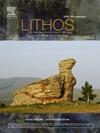Analyses across a mid-ocean ridge give the scale of plume-fed heterogeneity
IF 2.5
2区 地球科学
Q2 GEOCHEMISTRY & GEOPHYSICS
引用次数: 0
Abstract
The primary spatial scale of heterogeneity in the Earth's upper mantle, introduced from plume sources thousands of kilometres in scale at the base of the mantle, is critical for understanding mantle convection but is poorly constrained. Here, we demonstrate a geochemical shift in a set of lava samples collected from sites spaced approximately 10 km apart perpendicular to the Central Indian Ridge, which shows the length scale for a cross-section of concentric asthenospheric flow through the Réunion plume. This conclusion is derived from a mixing model that incorporates all expected mantle endmembers and common mantle components to reconstruct Sr–Nd–Pb isotopes and trace element profiles of lavas. The mixing model revealed that more than 95 % of the geochemical fingerprints of lavas are dictated by interactions between depleted mid-ocean ridge basalt mantle (DMM) and the prevalent mantle component of the plume (PREMA). The remaining, more specific features are contributed by varying proportions of enriched mantle components for each volcanic stage, reflecting the proposed archetypal chemical structure of the plume source at the base of the mantle. The latter additional components are concentrated in the core of the asthenospheric plume flow, which provides the primary short-length-scale (<10 km) heterogeneity in the upper mantle. Material transport from the lower mantle to the upper mantle thus occurs on a scale one order of magnitude smaller than that of seismic detection. This result provides a high-resolution constraint on solid-Earth convection models.

跨洋中脊的分析给出了羽流非均质性的尺度
地球上地幔非均质性的主要空间尺度是由地幔底部数千公里尺度的羽流源引入的,这对于理解地幔对流至关重要,但却缺乏约束。在这里,我们展示了一组熔岩样本的地球化学变化,这些样本采集于垂直于印度中脊的距离约为10公里的地点,这表明了通过r union羽流的同心软流层横截面的长度尺度。这一结论是通过一个混合模型得到的,该模型结合了所有预期的地幔端元和共同的地幔组分,重建了熔岩的Sr-Nd-Pb同位素和微量元素剖面。混合模型表明,95%以上的熔岩地球化学指纹是由枯竭的洋中脊玄武岩地幔(DMM)和羽流的主地幔组分(PREMA)之间的相互作用决定的。其余的更具体的特征是由于每个火山阶段不同比例的富集地幔成分所贡献的,反映了所提出的地幔底部羽流源的原型化学结构。后者的附加成分主要集中在软流圈地幔柱流的核心,提供了上地幔主要的短长度尺度(10 km)非均质性。因此,物质从下地幔到上地幔的运输,其规模比地震探测的规模小一个数量级。这一结果为固体地球对流模型提供了高分辨率约束。
本文章由计算机程序翻译,如有差异,请以英文原文为准。
求助全文
约1分钟内获得全文
求助全文
来源期刊

Lithos
地学-地球化学与地球物理
CiteScore
6.80
自引率
11.40%
发文量
286
审稿时长
3.5 months
期刊介绍:
Lithos publishes original research papers on the petrology, geochemistry and petrogenesis of igneous and metamorphic rocks. Papers on mineralogy/mineral physics related to petrology and petrogenetic problems are also welcomed.
 求助内容:
求助内容: 应助结果提醒方式:
应助结果提醒方式:


